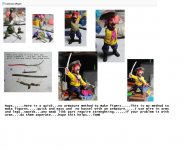Naps...just Naps
Specialist
- Joined
- Sep 10, 2010
- Messages
- 360
Hi,
I’ve started to do some scratch built soldiers for my own use and there is one phase of the toy soldier sculpting process that has me beaten at the moment and that is how to divide/cut the figure up for the moulding process without damaging the sculpture or losing any of the figure or details.
I make my figures by first creating a wire skeleton. I use Milliput to build the figure up and then complete all the uniform and other details. Just like I have seen other people do.
The figure is then in its completed state ready for moulding. Because I am using a two part moulding system I then need to take off arms, packs and weapons etc.
Taking off the packs, water bottles and weapons is no problem because they are just Milliput. The problem comes trying to take an arm off the figure.
My figure has a wire skeleton running through the whole body. So I have to cut through the Milliput and into the wire underneath which is very difficult and so far has always resulted in re-work and repair of the figure because of damage caused during limb removal.
I also have the added problem of having to drill away some of the wire to make a plug socket for the arm that’s been removed.
I’m pleased with the final look of my figures but I’m taking far too long over each figure because of all the rework and messing around. It takes some of the pleasure out of it when you mess up your initial sculpture.
Does anyone know of a way around this problem? Or does anyone have a different method of creating the figure in the first place?
Thanks
Paul
I’ve started to do some scratch built soldiers for my own use and there is one phase of the toy soldier sculpting process that has me beaten at the moment and that is how to divide/cut the figure up for the moulding process without damaging the sculpture or losing any of the figure or details.
I make my figures by first creating a wire skeleton. I use Milliput to build the figure up and then complete all the uniform and other details. Just like I have seen other people do.
The figure is then in its completed state ready for moulding. Because I am using a two part moulding system I then need to take off arms, packs and weapons etc.
Taking off the packs, water bottles and weapons is no problem because they are just Milliput. The problem comes trying to take an arm off the figure.
My figure has a wire skeleton running through the whole body. So I have to cut through the Milliput and into the wire underneath which is very difficult and so far has always resulted in re-work and repair of the figure because of damage caused during limb removal.
I also have the added problem of having to drill away some of the wire to make a plug socket for the arm that’s been removed.
I’m pleased with the final look of my figures but I’m taking far too long over each figure because of all the rework and messing around. It takes some of the pleasure out of it when you mess up your initial sculpture.
Does anyone know of a way around this problem? Or does anyone have a different method of creating the figure in the first place?
Thanks
Paul








